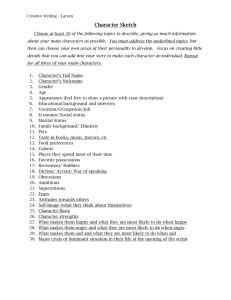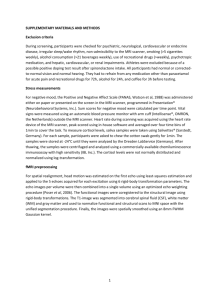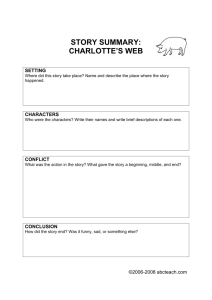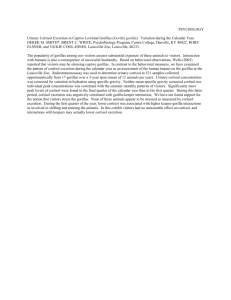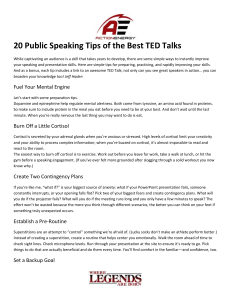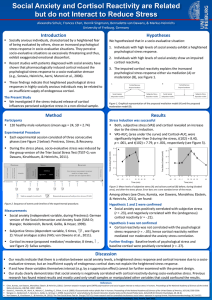Roelofs et al 2009a_BiolPychiat
advertisement
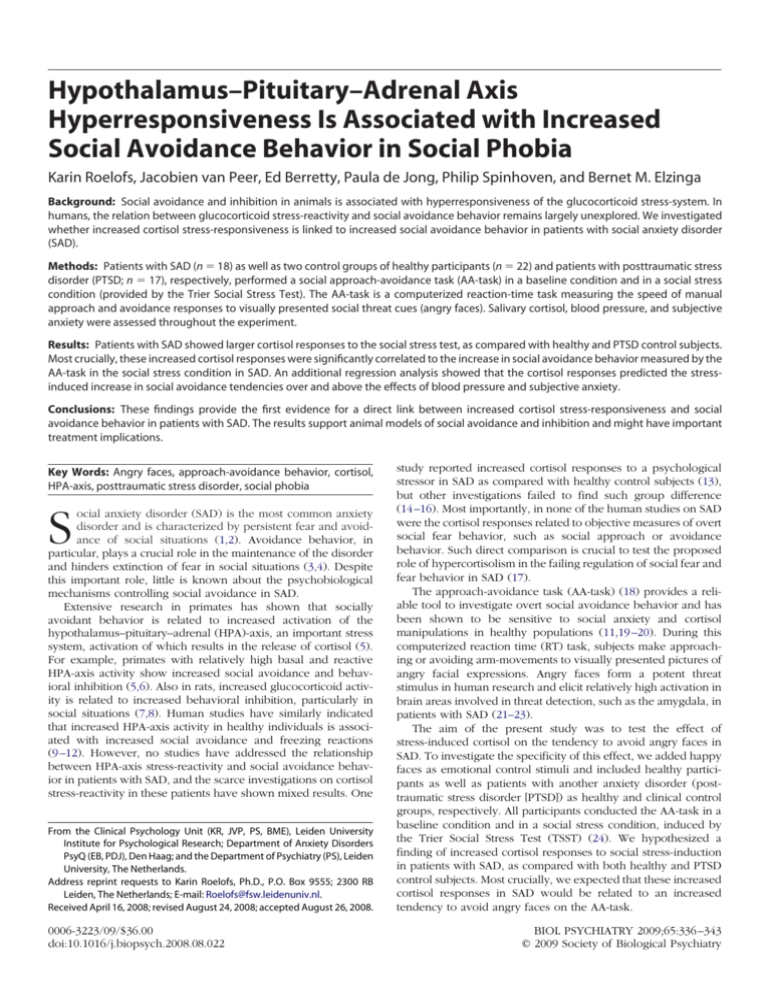
Hypothalamus–Pituitary–Adrenal Axis Hyperresponsiveness Is Associated with Increased Social Avoidance Behavior in Social Phobia Karin Roelofs, Jacobien van Peer, Ed Berretty, Paula de Jong, Philip Spinhoven, and Bernet M. Elzinga Background: Social avoidance and inhibition in animals is associated with hyperresponsiveness of the glucocorticoid stress-system. In humans, the relation between glucocorticoid stress-reactivity and social avoidance behavior remains largely unexplored. We investigated whether increased cortisol stress-responsiveness is linked to increased social avoidance behavior in patients with social anxiety disorder (SAD). Methods: Patients with SAD (n ⫽ 18) as well as two control groups of healthy participants (n ⫽ 22) and patients with posttraumatic stress disorder (PTSD; n ⫽ 17), respectively, performed a social approach-avoidance task (AA-task) in a baseline condition and in a social stress condition (provided by the Trier Social Stress Test). The AA-task is a computerized reaction-time task measuring the speed of manual approach and avoidance responses to visually presented social threat cues (angry faces). Salivary cortisol, blood pressure, and subjective anxiety were assessed throughout the experiment. Results: Patients with SAD showed larger cortisol responses to the social stress test, as compared with healthy and PTSD control subjects. Most crucially, these increased cortisol responses were significantly correlated to the increase in social avoidance behavior measured by the AA-task in the social stress condition in SAD. An additional regression analysis showed that the cortisol responses predicted the stressinduced increase in social avoidance tendencies over and above the effects of blood pressure and subjective anxiety. Conclusions: These findings provide the first evidence for a direct link between increased cortisol stress-responsiveness and social avoidance behavior in patients with SAD. The results support animal models of social avoidance and inhibition and might have important treatment implications. Key Words: Angry faces, approach-avoidance behavior, cortisol, HPA-axis, posttraumatic stress disorder, social phobia S ocial anxiety disorder (SAD) is the most common anxiety disorder and is characterized by persistent fear and avoidance of social situations (1,2). Avoidance behavior, in particular, plays a crucial role in the maintenance of the disorder and hinders extinction of fear in social situations (3,4). Despite this important role, little is known about the psychobiological mechanisms controlling social avoidance in SAD. Extensive research in primates has shown that socially avoidant behavior is related to increased activation of the hypothalamus–pituitary–adrenal (HPA)-axis, an important stress system, activation of which results in the release of cortisol (5). For example, primates with relatively high basal and reactive HPA-axis activity show increased social avoidance and behavioral inhibition (5,6). Also in rats, increased glucocorticoid activity is related to increased behavioral inhibition, particularly in social situations (7,8). Human studies have similarly indicated that increased HPA-axis activity in healthy individuals is associated with increased social avoidance and freezing reactions (9 –12). However, no studies have addressed the relationship between HPA-axis stress-reactivity and social avoidance behavior in patients with SAD, and the scarce investigations on cortisol stress-reactivity in these patients have shown mixed results. One From the Clinical Psychology Unit (KR, JVP, PS, BME), Leiden University Institute for Psychological Research; Department of Anxiety Disorders PsyQ (EB, PDJ), Den Haag; and the Department of Psychiatry (PS), Leiden University, The Netherlands. Address reprint requests to Karin Roelofs, Ph.D., P.O. Box 9555; 2300 RB Leiden, The Netherlands; E-mail: Roelofs@fsw.leidenuniv.nl. Received April 16, 2008; revised August 24, 2008; accepted August 26, 2008. 0006-3223/09/$36.00 doi:10.1016/j.biopsych.2008.08.022 study reported increased cortisol responses to a psychological stressor in SAD as compared with healthy control subjects (13), but other investigations failed to find such group difference (14 –16). Most importantly, in none of the human studies on SAD were the cortisol responses related to objective measures of overt social fear behavior, such as social approach or avoidance behavior. Such direct comparison is crucial to test the proposed role of hypercortisolism in the failing regulation of social fear and fear behavior in SAD (17). The approach-avoidance task (AA-task) (18) provides a reliable tool to investigate overt social avoidance behavior and has been shown to be sensitive to social anxiety and cortisol manipulations in healthy populations (11,19 –20). During this computerized reaction time (RT) task, subjects make approaching or avoiding arm-movements to visually presented pictures of angry facial expressions. Angry faces form a potent threat stimulus in human research and elicit relatively high activation in brain areas involved in threat detection, such as the amygdala, in patients with SAD (21–23). The aim of the present study was to test the effect of stress-induced cortisol on the tendency to avoid angry faces in SAD. To investigate the specificity of this effect, we added happy faces as emotional control stimuli and included healthy participants as well as patients with another anxiety disorder (posttraumatic stress disorder [PTSD]) as healthy and clinical control groups, respectively. All participants conducted the AA-task in a baseline condition and in a social stress condition, induced by the Trier Social Stress Test (TSST) (24). We hypothesized a finding of increased cortisol responses to social stress-induction in patients with SAD, as compared with both healthy and PTSD control subjects. Most crucially, we expected that these increased cortisol responses in SAD would be related to an increased tendency to avoid angry faces on the AA-task. BIOL PSYCHIATRY 2009;65:336 –343 © 2009 Society of Biological Psychiatry BIOL PSYCHIATRY 2009;65:336 –343 337 K. Roelofs et al. Table 1. Demographic Variables and Group Characteristics Variable Gender (n: male/female) Age (yrs) Medicationa Antidepressants Sedativesb Otherc Oral contraceptives Social Anxiety (SPAI) Depression (BDI) Early Trauma (TEQ) Emotional Physical Sexual TSST-Modificationsk (n) Verbal encouragements Structured speech Speech terminated preterm Axis-1 Comorbidityl (n) Generalized anxiety d Obsessive compulsive d Panic d Depressive d Dysthymic d SAD n ⫽ 18 PTSD n ⫽ 17 HC n ⫽ 22 9M/9F 32.2 (⫾ 3.2) 7N/11Y 6 4 1 4 156 (⫾ 7.7)d 16.7 (⫾ 2.5)e 3.6 (⫾ .8) 1.6 (n ⫽ 8)h .6 (n ⫽ 3) .2 (n ⫽ 1) 11N/7Y 1 1 5 6M/11F 35.8 (⫾ 3.3) 4N/13Y 4 2 3 6 131 (⫾ 7.9)d 17.9 (⫾ 2.6)f 7.4 (⫾ 1.0)g 1.5 (n ⫽ 6) 1.9 (n ⫽ 9)i 2.0 (n ⫽ 9)j 11N/6Y 3 0 3 9M/13F 39.9 (⫾ 2.9) 17N/5Y 0 0 2 4 89 (⫾ 7.0)d 3.7 (⫾ 2.3)ef 2.7 (⫾ .8)g .5 (n ⫽ 5)h .5 (n ⫽ 4)i .1 (n ⫽ 1)j 21N/1Y 1 0 0 2 1 0 7 1 2 2 3 4 1 F Value p .8 (2) 1.5 12.2 (2) ns ns .002 21.9 10.9 7.9 2.0 4.2 12.9 6.8 (2) ⬍.001 ⬍.001 ⬍.001 .1 .020 ⬍.001 .033 0 0 0 0 0 Data from questionnaires are presented in mean score and SEM. SAD, social anxiety disorder; PTSD, posttraumatic stress disorder; HC, healthy control subjects; N, no; Y, yes; BDI, Beck Depression Inventory; SPAI, Social Phobia and Anxiety Inventory; TEQ, Traumatic Experiences Questionnaire; d, disorder. a Total numbers do not correspond to the sum of the four subtypes, because of overlap (patients might use more than one type of medication). b Participants refrained from taking the drug minimally 24 hours before the experiment. c Including medication for respiratory tracts and blood pressure control. d–j Cells with similar superscripts differ significantly from each other (p ⬍ .05). k See “Procedures” section for a detailed description of the Trier Social Stress Test (TSST) modifications. l Assessed with the Structured Clinical Interview for DSM-IV Axis-I Disorders (SCID-i/p). Methods and Materials Participants Demographic variables and group characteristics of the three participant-groups are presented in Table 1. Patients with generalized SAD and PTSD had been referred for outpatient treatment to a general psychiatric hospital and were diagnosed with the Structured Clinical Interview for DSM-IV Axis-I Disorders (SCID-i/p) (25). Only PTSD patients with a history of interpersonal trauma (physical and/or sexual abuse) were included, because they are also characterized by marked fear and avoidance of social situations. Healthy control (HC) participants were recruited via advertisements in local newspapers. Exclusion criteria for participation were: age ⬍ 18 or ⬎ 65 years, lefthandedness, psychotic disorder, use of neuroleptics, substance use/addiction, a chronic disease, use of corticosteroids max 6 months before participation, and pregnancy or breast feeding. Of the 22 SAD patients originally tested, 4 patients had to be excluded (due to excessive blood pressure, n ⫽ 1; missing AA-task data due to technical problem, n ⫽ 2; and immediate termination after introduction TSST, n ⫽ 1), leaving 18 SAD patients for the analyses. Of the 20 PTSD patients tested, 3 were excluded (heart rhythm disturbances, n ⫽ 1; technical problems, n ⫽ 2), leaving a total of 17 PTSD patients. None of the 22 HC participants were excluded. Before the test day, all participants were instructed to minimize physical exercise and not to smoke during the hour preceding the experiment and not to take large meals, coffee, and drinks with low pH during the night (from 8:00 PM on) and morning preceding the test day, because these variables can affect cortisol levels. All participants agreed on this procedure, and nobody reported difficulty with abstaining from caffeine or nicotine. All participants had normal or corrected-to-normal vision and provided written informed consent. The study was approved by the local ethics committee. AA-Task In this affect-evaluation task (18), participants respond to visually presented pictures displaying emotional facial expressions, by making arm movements toward (arm-flexion or approach) or away from (arm-extension or avoid) their own body. Eighty pictures with facial expressions (26 –29) served as stimuli. Both the happy and angry expressions were taken from the same model (total of 40 models [50% male]). The stimuli were subdivided into four fixed series (A1-A2-B1-B2) with each 10 happy and 10 angry expressions from different models. Each picture was presented on a 15-inch computer screen with a vertical visual angle of 14° and a horizontal visual angle of 10.7°. The approach and avoidance responses were given by means of three one-button boxes that were fixed to a vertical stand (see Rotteveel and Phaf [18] for a photograph of this experimental set-up). Participants were seated to the left of the stand, allowing them to respond with their right hand. For the resting position of the right hand participants were instructed to push the homebutton (fixed in the middle) loosely with the back of the right hand as long as no response was given, ensuring that the www.sobp.org/journal 338 BIOL PSYCHIATRY 2009;65:336 –343 movement distance for approach and avoidance responses would be equal. All subjects received an affect-congruent and an affect-incongruent instruction-block of trials, both before (A1A2) and after (B1-B2) stress-induction. In affect-congruent instruction-blocks, participants were instructed to press the upper button (approach movement) in response to a happy face and to press the lower button in response to an angry face (avoidance movement). Affect-incongruent instruction blocks involved the opposite stimulus-response mappings (approach-angry, avoidhappy). No reference was made in the instructions to congruence and incongruence, approach and avoidance, or arm flexion and extension. The order of instructions before and after stressinduction was fully counterbalanced across subjects. Each instruction-block was preceded by 12 practice trials containing pictures not included in the experiment. Trials started with a 100-msec-lasting black fixation point at the center of the screen. After an interval of 300 msec (blank screen), the face-stimulus was presented for 100 msec, with an inter-trial-interval (ITI) of 1500 msec. The RT (time between stimulus-onset and response) was measured with an accuracy of ⬍ 2 msec. TSST This psychological challenge test consists of a free speech (5 min) and a mental arithmetic task (5 min), performed in front of an audience of three individuals and preceded by an anticipation phase (5 min), in which participants prepare the public speech. During the speech participants take on the role of a job applicant (job definition is predefined, on the basis of what is challenging and relevant for the participant—see [24] for exact describtion). This 15-min protocol has been found repeatedly to induce significant endocrine and cardiovascular responses in approximately 70 % of the participants (24). In case participants reported being unable to proceed with the free speech, they received a modified version of the TSST, with up to three measures helping participants to fulfill the task, without dropping out. The measures were in fixed order, and the next step was only applied if necessary: 1) giving verbal encouragements during the free speech; 2) structured interview in stead of free speech, involving direct questions about job application; and 3) preterm cancellation of free speech, and immediate continuation with the mental arithmetic task. The modifications applied in each group are indicated in Table 1. Physiological and Subjective Measures Salivary cortisol, blood pressure, and subjective anxiety were measured to assess glucocorticoid, autonomic, and subjective stressresponses, respectively. All three stress-measures were obtained at 10 assessment points over a 130-min period at ⫺65, ⫺35, ⫺25, ⫺10, 0, ⫹15, ⫹25, ⫹40, ⫹50 and ⫹65 min, respectively, with reference to the start of the stressor (see Figure 1). All assessments were performed between 1:00 PM and 4:00 PM. To assess free cortisol levels, saliva samples were obtained with Salivette collection devices (Sarstedt, Rommelsdorf, Germany). The samples were stored at ⫺20°C before assaying. Biochemical analysis of free cortisol in saliva was performed with a competitive electrochemiluminescence immunoassay (ECLIA; Elecsys 2010, Roche Diagnostics, Basel, Switzerland), as described elsewhere (30). Blood pressure (diastolic) was measured from the nondominant arm with an automatic blood pressure monitor (Omron R5-I) that could be initiated manually. Subjective anxiety was rated on a 10-cm visual analogue scale ranging from “not anxious” to “very anxious”. www.sobp.org/journal K. Roelofs et al. Figure 1. Cortisol responses before and after stress exposure with the Trier Social Stress Test (TSST). Patients with social anxiety disorder (SAD) have larger cortisol responses to the TSST than both control groups of healthy subjects (HC) and patients with posttraumatic stress disorder (PTSD). AA, approach-avoidance. Questionnaires The social anxiety subscale of the Social Phobia and Anxiety Inventory (31,32) is a 32 item self-report scale measuring social anxiety. Scores range from 0 to 192. The Beck Depression Inventory (BDI-II) (33,34) is a 21-item self-report questionnaire that measures depressive symptoms during the past week. Scores range from 0 to 63. The Traumatic Experiences Checklist (35) is a 26-item self-report inventory assessing emotional, physical, and sexual abuse. The total score ranges from 0 to 26, the emotional abuse score from 0 to 6, the physical abuse score from 0 to 5, and the sexual abuse score from 0 to 6. Procedure All participants visited the lab twice. On the first (assessment) day, a trained psychologist administered the SCID-i/p (25) and the questionnaires (see Table 1). On the second (test) day, participants arrived at the laboratory at 1:00 PM. After the first series of physiological and subjective assessments, subjects were adjusted to the experimental environment with a relaxing movie. The baseline administration of the AA-task took place after the third assessment (⫺25 min with reference to the onset of the stressor; Figure 1). After two additional cognitive tests (an attention and a learning test, of which results will be reported elsewere) the experimenter introduced the TSST that was administered by three other experimentors (audience). After the TSST, the audience called the experimenter back into the room and requested him to administer the cognitive tests, including the AA-task again in their presence (⫹25 min with reference to onset TSST). In this way, the social evaluation context remained present during the second administration of the AA-task. Subsequently, the audience left the room and returned for a debriefing after the last physiological assessment had taken place. One week after the experiment, patients were contacted for a second debriefing. Statistical Analyses Reaction time outliers were filtered with a ⬍150- and ⬎1000msec cut-off. For each participant, the median of the remaining RTs (97%) for the correct responses were calculated/cell (defined by Condition [baseline, stress], Valence [happy, angry face], and Movement [approach, avoid]). The influence of stress-induction on the stress measures and the task performance was tested with K. Roelofs et al. BIOL PSYCHIATRY 2009;65:336 –343 339 Results the subjects with TSST-modifications were excluded [F (2,34) ⫽ 3.40, p ⫽ .05, 2 ⫽ .15] but not when TSST-modifications were not controlled for [F (2,52) ⫽ 2.45, ns]. Diastolic Blood Pressure. A significant main effect of Time F (7,352) ⫽ 13.22, p ⬍ .001, 2 ⫽ .20] indicated increased blood pressure after stress-induction as compared with baseline. There were no effects involving Group (all p ⬎ .2). Subjective Anxiety. There were significant main effects of Time [F(5,267) ⫽ 44.05, p ⬍ .001, 2 ⫽ .45] and Group [F(2,54) ⫽ 12.91, p ⬍ .001, 2 ⫽ .32]. These effects remained present when controlling for gender, medication, and TSST-modification by entering these variables as covariates into the analysis (all p ⬍ .05). None of the covariates yielded a significant effect (all p ⬎ .3). Post hoc “two-Group” comparisons indicated that both patient groups scored higher than HC subjects [“SAD-versus-HC”: F(1,38) ⫽ 26.39, p ⬍ .001, 2 ⫽ .41; “PTSD-versus-HC”: F(1,37) ⫽ 18.67, p ⬍ .001, 2 ⫽ .34] but did not differ mutually [“SAD-versus-PTSD”: F(1,36) ⫽ .46, ns]. In sum, stress-induction was successful, as evidenced by significant Time-effects on all stress measures. Most importantly, in agreement with our first hypothesis, SAD patients showed significantly larger stress-induced cortisol levels, as compared with both healthy and PTSD control subjects. In contrast, stressinduction did not elicit (additional) differential group effects for blood pressure and subjective anxiety. Stress Measures Separate two-way ANOVAs rm were conducted for each of the three stress-measures (cortisol, blood pressure, and subjective anxiety) with within-subject factor Time (10 assessment points) and between-subject factor Group. Cortisol. Analysis of the three subject-groups together yielded a trend toward a main effect of Group [F (2,54) ⫽ 2.54, p ⫽ .08, 2 ⫽ .09; see Figure 1]. This effect remained present when controlling for gender, medication, and TSST-modifications, by adding these variables as covariates to the analysis [F (2,51) ⫽ 3.18, p ⫽ .050, 2 ⫽ .11]. The TSST-modification was the only covariate showing a significant main effect [F (1,51) ⫽ 4.51, p ⫽ .039, 2 ⫽ .08]. Post hoc “two-Group” comparisons (while controlling for the effects of TSST-modification) showed significant Group-effects for “SAD-versus-HC” [F (1,37) ⫽ 4.61, p ⫽ .038, 2 ⫽ .11] and for “SAD-versus-PTSD” [F (1,32) ⫽ 4.56, p ⫽ .041, 2 ⫽ .13] but not for the “HC-versus-PTSD” comparison [F (1,36) ⫽ .12, ns]. Most crucially, a Group ⫻ Time interaction emerged for both “SAD-versus-HC” [F (2,60) ⫽ 4.44, p ⫽ .022, 2 ⫽ .11] and “SAD-versus-PTSD” [F (2,53) ⫽ 3.34, p ⫽ .050, 2 ⫽ .09] but not for the “HC-versus-PTSD” comparison [F (3,98) ⫽ .86, ns]. These Group ⫻ Time interactions were explained by the fact that SAD patients had larger cortisol responses than both control groups after stress-induction [assessment 6-10; SAD-HC: F (1,37) ⫽ 4.36, p ⫽ .044, 2 ⫽ .11; SAD-PTSD: F (1,32) ⫽ 4.75, p ⫽ .037, 2 ⫽ .13] but not at baseline (assessment 1-5: all p ⬎ .35) (Figure 1). Further analyses to reveal the effects of TSSTmodifications in the SAD group demonstrated that SAD patients who received TSST-modifcations (n ⫽ 7) had significantly lower cortisol responses as compared with those who underwent the original TSST [n ⫽ 11: F (1,21) ⫽ 4.10, p ⫽ .05, 2 ⫽ .21]. For this reason, the SAD-versus-HC comparison yielded a significant Group ⫻ Time interaction, either when controlling for TSSTmodifications (see preceding text) or when excluding participants that received TSST-modifications [F (2,45) ⫽ 4.38, p ⫽ .029, 2 ⫽ .13] but not when TSST-modifications were not accounted for [F (2,57) ⫽ 1.22, ns]. Similarly, the Group ⫻ Time interaction for the SAD-versus-PTSD comparison remained significant, when Effects of Stress-Induced Cortisol on Threat Avoidance in SAD To test our second hypothesis (stress-induced cortisol predicts avoidance of angry faces on the AA-task in SAD) we conducted a two-way ANOVA-rm for the RTs for angry faces, with Condition (baseline, stress) and Movement (approach, avoid) as within-subject factors and the individual cortisol levels (AUCg) as a continuous factor. The results showed a significant Condition ⫻ Movement effect [F(1,16) ⫽ 5.49, p ⫽ .032, 2 ⫽ .26], reflecting a significant effect of Movement during stress [F(1,16) ⫽ 8.63, p ⫽ .009, 2 ⫽ .34] but not at baseline [F(1,16) ⫽ .64, ns] in SAD. These findings indicate that SAD patients are faster in avoiding than approaching angry faces (AA-effect) in the social stress condition (see Figure 2 and Table 2). Most importantly, a significant Condition ⫻ Movement ⫻ Cortisol interaction [F(1,16) ⫽ 6.55, p ⫽ .021, 2 ⫽ .29] indicated that the patients’ cortisol levels correlated significantly with the stress-induced increase in AA-effects. Pearson correlations between the cortisol levels and the stress-induced change in AA-effects (⌬ AA-effects) showed that the direction of this correlation was positive (r ⫽ .54, p ⫽ .02; see Figure 3A), indicating that high cortisol levels are associated with an increased tendency to avoid social threat in SAD. There was no such relation for the HC subjects (r ⫽ ⫺.06, p ⫽ .79; Figure 3B) or for the PTSD control subjects (r ⫽ .13, p ⫽ .63). To test whether the Condition ⫻ Movement effect in SAD remained present when controlling for Gender, Medication, and TSST-modifications, these variables were entered as covariates in the two-way ANOVA-rm. Both the Condition ⫻ Movement [F (1,13) ⫽ 4.60, p ⫽ .05, 2 ⫽ .26] and the Condition ⫻ Movement ⫻ Cortisol [F (1,13) ⫽ 5.17, p ⫽ .041, 2 ⫽ .29] interactions remained significant, and there were no main effects for the covariates (all p ⬎ .2). In addition, we controlled for depression rates by entering the individual BDI-II total-scores as a covariate in the two-way ANOVA-rm. Both the Condition ⫻ Movement [F(1,15) ⫽ 9.50, p ⫽ .008, 2 ⫽ .39] and the Condition ⫻ Movement ⫻ Cortisol [F(1,15) ⫽ 7.45, p ⫽ .015, 2 ⫽ .36] interactions remained significant, and there was no main effect for the depression rates [F(1,15) ⫽ .74, ns]. Finally, to test whether cortisol predicted the stress-induced repeated measures analysis of variance (ANOVA-rm). Because gender and use of medication can influence the cortisol stressresponse (24) and because groups differed with respect to the TSST-modifications, we controlled for these variables in a separate analysis by including gender, medication, and TSST-modifications as covariates (analysis of covariance). The total cortisol response for each participant was computed with the area under the curve with reference to the ground (AUCg) (see Pruessner et al. [36] -formula 2). The effect of cortisol responses on the task performance in SAD was analyzed by entering the individual cortisol responses (AUCg) as a continuous factor into the analyses (analysis of covariance) (see Judd et al. [37]). Significant interactions including this factor were followed up by calculating Pearson correlations between this factor and the within-subject effects. The specificity of the effect of cortisol among other stress measures was tested with an additional linear regression analysis with cortisol, blood pressure, and subjective anxiety (all in AUCg) as predictors and the “stress-induced change in task performance” as dependent variable. For all analyses ␣ was .05. Effect-sizes of significant results are reported with the Partial Eta Squared (2). Within-subject effects are reported with Greenhouse-Geisser correction. www.sobp.org/journal 340 BIOL PSYCHIATRY 2009;65:336 –343 www.sobp.org/journal 685 (24) 2.8 (1.6) 671 (20) 4.2 (2.2) 635 (23) 4.3 (1.3) 684 (27) 5.9 (1.7) 696 (26) 4.9 (1.4) 697 (26) 4.6 (1.7) 661 (17) 5.3 (1.6) 700 (23) 9.5 (2.5) 680 (19) 7.4 (1.8) 674 (22) 7.2 (2.5) av app PTSD Stress 632 (23) 7.6 (1.4) 702 (31) 5.8 (1.7) 701 (30) 2.6 (1.7) 668 (25) 4.4 (1.6) 683 (26) 6.6 (1.6) 669 (20) 9.6 (2.2) 695 (24) 7.5 (2.1) 708 (22) 6.7 (2.4) 693 (24) 3.9 (2.1) 713 (22) 6.2 (2.4) app av av app PTSD app Baseline Values presented as mean (SEM). RT, reaction time in msec; ER, error rate in %; app, approach; av, avoid; other abbreviations as in Table 1. 680 (26) 6.6 (1.4) 683 (27) 4.1 (1.5) 720 (18) 6.5 (1.8) 667 (21) 9.4 (1.9) av app SAD HC Angry Face Responses RT ER Happy Face Responses RT ER change in AA-effects over and above the effects of blood pressure and subjective anxiety, the relative contribution of these three stress measures (all in AUCg) on the ⌬ AA-effects were tested in a regression analysis. The total model explained a statistically significant part of 68% of the variance of the ⌬ AA-effects [R2 ⫽ .46, F(3,16) ⫽ 3.65, p ⫽ .042], and cortisol was the only significant predictor (see Table 3). Together these findings support our second hypothesis that stress-induced cortisol is related to an increase in social avoidance in patients with SAD. SAD Figure 2. Reaction times (RT; in msec) for approach and avoidance movements toward angry faces on the AA-task in patients with SAD, patients with PTSD, and HC subjects. A significant Condition (Baseline, Stress) ⫻ Movement (Approach, Avoid) interaction for SAD patients indicated that social stress induction resulted in increased AA-effects for angry faces. Groups only differed during stress and not at baseline, indicating larger AA-effects for angry faces in SAD, as compared with PTSD and HC. Abbreviations as in Figure 1. *p ⬍ .05; **p ⬍ .01. Table 2. Mean RTs and ERs for Approach and Avoidance Responses to Angry and Happy Faces on the AA-Task for Each Group in Baseline and Stress Conditions av app HC av K. Roelofs et al. BIOL PSYCHIATRY 2009;65:336 –343 341 K. Roelofs et al. Figure 3. Correlation between cortisol levels (area under the curve [AUCg]) and stress-induced change in approach-avoidance effect (⌬ AA-effect) for angry faces in patients with social anxiety disorder (SAD) (A) and healthy control (HC) subjects (B). The scatterplot in A shows that high cortisol levels are associated with increased AA-effects after stress induction, indicating that high glucocorticoid stress-responsiveness in SAD is associated with a stress-induced increase in the tendency to avoidance of angry faces. There was no such effect in HC subjects (B). AA-effect, RT approach ⫺ RT avoid; ⌬ AA-effect ⫽ ([ “RT approach ⫺ RT avoid” in stress] ⫺ [“RT approach ⫺ RT avoid” at baseline]). Positive ⌬ AA-effects indicate larger AA-effects after stress, as compared with baseline. RT, reaction time. In both control groups, the same Condition ⫻ Movement ANOVA-rm for the angry face responses did not yield significant effects (all p ⬎ .4; see Figure 2). Visual inspection of Figure 2 suggests a group difference in AA-effects in the stress-condition. We tested this additional hypothesis for the stress-condition with a two-way ANOVA-rm with within-subject factor Movement and between-subject factor Group and indeed found a significant Group ⫻ Movement interaction in the stress-condition [F (2,54) ⫽ 3.71, p ⫽ .031, 2 ⫽ .12], indicating that the earlier reported Movement-effect for SAD was not present for HC and PTSD groups (all p ⬎ .2). There was no such group difference at baseline [F (2,54) ⫽ .23, ns]. There were no effects involving Condition or Group for the happy face responses or for the error rates (all p ⬎ .1; see Table 2). Discussion The purpose of the present study was to investigate the effects of stress-induced cortisol on social avoidance behavior in patients with SAD. Three major findings emerged from the present study. First, patients with SAD, as compared with both healthy and PTSD control subjects, showed increased cortisol responses to social stress-induction. Second, social stress elicited increased avoidance tendencies toward social threat stimuli in SAD. Most crucially, the cortisol responses predicted the increase in social avoidance tendencies during stress in patients with SAD. This effect remained after controlling for possible confounders such as gender and medication. Moreover, cortisol predicted social avoidance behavior over and above the effects of blood pressure and subjective anxiety. Our findings of increased cortisol stress-reactivity in SAD confirm findings by Condren et al. (13), indicating increased (plasma) cortisol in response to a mental arithmetic/working memory task in SAD. The results contrast with findings by Martel et al. (14) and Levin et al. (15) who applied a public speaking task in adolescent and adult SAD patients, respectively. Also Furlan et al. (16) found no differential cortisol responses comparing SAD patients and HC subjects when speaking in front of a camera (although comparison of only the cortisol-responders within each group yielded larger cortisol levels for SAD-responders). One possible explanation for the nonsignificant findings in most of the previous studies is that patients with SAD tend to show less compliance to the stress-protocol than HC. None of the previous studies on social evaluation-stress in SAD provided information on protocol-compliance or drop-out. However, 7 of our 18 SAD patients reported being unable to proceed with the TSST during the public speaking task. To prevent these patients from dropping out, we formalized up to three mild modifications (e.g., verbal encouragements, structured interview, or preterm termination of the free speech). These patients who initially expressed the highest distress during the task showed significantly lower cortisol responses than those who completed the task without modifications. As a result, some group differences in cortisol response only emerged when controlling for these modifications. This finding indicates that even mild protocol violations might critically reduce the cortisol responses and should be taken into account in future studies. The SAD patients showed significant avoidance tendencies to angry faces on the AA-task (19). This effect was particularly pronounced in a condition of social evaluation-stress (11,38), in line with previous findings in highly anxious subjects. Most importantly, the present study is the first to show a relation between an objective measure of social avoidance behavior and cortisol stress-responses in patients with SAD. Stress-induced increases in avoidance tendencies were positively correlated to the cortisol responses. This finding shows an interesting parallel with primate studies demonstrating social fear behavior, such as social avoidance and freezing, to be associated with increased cortisol stress-reactivity (5,6). The findings also fit with findings by van Peer et al. (20) showing that cortisol administration resulted in increased AA-effects in high (and not low) socially anxious subjects. Cortisol also increased the processing of the angry faces in these subjects only, as evidenced by increased P2 amplitudes in the electroencephalogram for angry-avoid trials, which might indicate that cortisol facilitates threat avoidance in high anxious individuals. This interpretation fits theories suggesting that cortisol plays an important role in the regulation of the stress-response and the selection of behavioral responses such as an avoidance response (5,13,39) and might explain our findings of faster avoidance as compared with approach responses during stress. Alternatively, the relatively larger RT costs for angryapproach trials in the social stress-context might result from the direct effects of cortisol on prefrontal inhibitory functioning. Affect-incongruent angry-approach trials require the inhibition of an automatic response-tendency (avoid angry face) and the selection of a counter-intuitive response, and both are frontal functions as indicated by a recent functional magnetic resonance imaging study using the same AA-task (40). Several studies have demonstrated that stress-levels cortisol can impair frontal (often Table 3. Regression Analysis Predicting the Stress-Induced Increase in ⌬ AA-Effect for Angry Faces in Patients with SAD Predictor (Constant) Cortisol (AUCg) Diastolic Blood Pressure (AUCg) Subjective Anxiety (AUCg)  T p .68 .11 .40 ⫺1.46 2.65 .46 1.74 ns .02 ns ns Total model: R2 ⫽ .46 [F(3,16) ⫽ 3.65, p ⫽ .042]. ⌬ AA-effect, approach-avoidance effects for angry faces; SAD, social anxiety disorder; AUCg, area under the curve with reference to the ground. www.sobp.org/journal 342 BIOL PSYCHIATRY 2009;65:336 –343 stress-irrelevant) functions such as working memory and inhibitory control (41,42). A similar mechanism might also have caused the high RT costs for the affect-incongruent angryapproach trials in SAD. A strength of the present study is that stress-induced cortisol was investigated in direct relation with social avoidance performance in SAD. Also, possible TSST modifications were fully formalized. A limitation is the fact that only free cortisol was measured. However, the methods to assess other HPA-axis measures (such as corticotropin-releasing hormone) are invasive and of potential threat for requiring good (stress-free) baseline assessments (24,43). The effect sizes for the cortisol-responses were relatively small, and the fact that we found no significant cortisol and avoidance responses in PTSD control subjects might be related to the social nature of the TSST and the AA-task. Additional research in other anxiety disorders using disorderspecific materials is needed to identify the specificity of the effects (44). Also, although cortisol predicted a significant part of the change in approach-avoidance tendencies in SAD patients, other elements of the social stress condition might have contributed to this effect as well. Further research is needed to disentangle the relative contribution of, for example, the presence of the audience during the second administration of the AA-task versus the preceding stressor. In addition, possible group differences in sensitivity to repeated administration of the AA-task might have confounded the results and should be accounted for in future studies. Finally, we should note that the relationship between cortisol and social avoidance is correlational in nature, allowing no causal interpretations. To conclude, the present findings for the first time show that high glucocorticoid stress-responses in SAD are associated with increased social avoidance tendencies during social exposure. Avoidance behavior plays a crucial maintaining role in SAD and forms a major target for clinical interventions, such as exposuretherapy. Our data suggest that high levels of endogenous cortisol during social exposure might hinder the execution of threatapproach behavior and might increase threat-avoidance behavior. An important implication might be that the level of stress (and stress-induced cortisol, in particular) during exposure therapy should be kept to a limit in order to achieve optimal benefits from the therapy. These findings are in line with the systematic desensitization approach originally formulated by Wolpe (45) requiring the therapist to initiate only small amounts of distress in the patient. As a step further along these lines, individual glucocorticoid stress-sensitivity might be assessed to tailor and fine tune psychological and pharmacological interventions in patients with SAD. This study was supported by VENI Grants (#451-02-115) and (#451-02-116) from the Netherlands Organization for Scientific Research (NWO) awarded to Dr. K. Roelofs and Dr. B. Elzinga, respectively. We thank Mark Rotteveel for providing the AA-task software and response-stand; Mea-Ann Haime, Gisella Lijde, Willemieke Maasland, Jaques Meulman, Saskia van Bodegom, Jocelyn van de Moolen, Sarah van der Zeeuw, Mariette van het Schip, Lennard van Ree, Robert van Roon, and the therapists from the anxiety and trauma units from PsyQ, The Hague, for their assistance during data collection; and Jolanda Verhagen and Hans van Pelt (Department of Clinical Chemistry, Leiden University Medical Centre [LUMC]) for conducting the cortisol analyses. The authors K. Roelofs, J. van Peer, E. Berretty, P. de Jong, Ph. www.sobp.org/journal K. Roelofs et al. Spinhoven, and B. Elzinga reported no biomedical financial interests or potential conflicts of interest. 1. Hofmann SG, Bogels SM (2006): Recent advances in the treatment of social phobia. J Cogn Psychoth 20:3–5. 2. Mannuzza S, Schneier FR, Chapman TF, Liebowitz MR, Klein DF, Fyer AJ (1995): Generalized social phobia. Reliability and validity. Arch Gen Psychiatry 52:230 –237. 3. Clark DM, Wells A (1995): A cognitive model of social phobia. In: Heimberg RG, Liebowitz, MR, Hope DA, Schneier FR, editors. Social Phobia: Diagnosis, Assessment and Treatment. New York: Guilford Press, 69 –93. 4. Stangier U, Heidenreich T, Schermelleh-Engel K (2006): Safety behaviors and social performance in patients with generalized social phobia. J Cogn Psychoth 20:17–31. 5. Sapolsky RM (1990): Adrenocortical function, social rank, and personality among wild baboons. Biol Psychiatry 28:862– 878. 6. Kalin NH, Shelton SE, Rickman M, Davidson RJ (1998): Individual differences in freezing and cortisol in infant and mother Rhesus monkeys. Behav Neurosci 112:251–254. 7. Nunez JF, Ferre P, Escorihuela RM, Tobena A, Fernandez-Teruel A (1996): Effects of postnatal handling of rats on emotional, HPA-axis, and prolactin reactivity to novelty and conflict. Physiol Behav 60:1355–1359. 8. Cavigelli SA, Stine MM, Kovacsics C, Jefferson A, Diep MN, Barrett CE (2007): Behavioral inhibition and glucocorticoid dynamics in a rodent model. Physiol Behav 92:897–905. 9. Van Honk J, Tuiten A, van den Hout M, Koppeschaar H, Thijsen J, de Haan E, Verbaten R (1998): Baseline salivary cortisol levels and preconscious selective attention for threat: A pilot study. Psychoneuroendocrinology 23:741–747. 10. Van Honk J, Tuiten A, van den Hout M, Koppeschaar H, Thijssen J, de Haan E, Verbaten R (2000): Conscious and preconscious selective attention to social threat: Different neuroendocrine response patterns. Psychoneuroendocrinology 25:577–591. 11. Roelofs K, Elzinga BM, Rotteveel M (2005): The effects of stress-induced cortisol responses on approach-avoidance behavior. Psychoneuroendocrinology 30:665– 677. 12. Roelofs K, Bakvis P, Hermans E, van Honk J (2007): The effects of stress and cortisol on the preconscious selective attention to social threat. Biol Psychol 75:1–7. 13. Condren RM, O’Neill A, Ryan MCM, Barrett P, Thakore JH (2002): HPA axis response to a psychological stressor in generalized social phobia. Psychoneuroendocrinology 27:693–704. 14. Martel FL, Hayward C, Lyons DM, Sanborn K, Varady S, Schatzberg AF (1999): Salivary cortisol levels in socially phobic adolescent girls. Depress Anxiety 10:25–27. 15. Levin AP, Saoud JB, Strauman T, Gorman JM, Fyer AJ, Crawford R Liebowitz MR (1993): Responses of “generalized” and “discrete” social phobics during public speaking. J Anxiety Disord 7:207–221. 16. Furlan PM, DeMartinis N, Schweizer E, Rickels K, Lucki I (2001): Abnormal salivary cortisol levels in social phobic patients in response to acute psychological but not psysical stress. Biol Psychiatry 50:254 –259. 17. Hermans E, van Honk J (2006): Toward a framework for defective emotion processing in social phobia, Cogn Neuropsychiatry 11:307–331. 18. Rotteveel M, Phaf RH (2004): Automatic affective evaluation does not automatically predsipose for arm flexion and extension. Emotion 4:156 – 172. 19. Heuer K, Rinck M, Bekker ES (2007): Avoidance of emotional facial expressions in social anxiety: The Approach–Avoidance Task. Behav Res Ther 45:2990 –3001. 20. Van Peer JM, Roelofs K, Rotteveel M, van Dijk JG, Spinhoven Ph, Ridderinkhof KR (2007): The effects of cortisol administration on approachavoidance behavior: An event-related potential study. Biol Psychol 76: 135–146. 21. Stein MB, Goldin PR, Sareen J, Zorrilla LT, Brown GG (2002). Increased amygdala activation to angry and contemptuous faces in generalized social phobia. Arch Gen Psychiatry 59:1027–1034. 22. Straube T, Kolassa I, Glauer M, Mentzel H, Miltner WHR (2004): Effect of task conditions on brain responses to threatening faces in social phobics: An event-related functional magnetic resonance imaging study. Biol Psychiatry 56:921–929. 23. Phan KL, Fitzgerald DA, Nathan PJ, Tancer ME (2006): Association between amygdala hyperactivity to harsh faces and severity of social anxiety in generalized social phobia. Biol Psychiatry 59:424 – 429. K. Roelofs et al. 24. Kirschbaum C, Pirke KM, Hellhammer DH (1993): The Trier Social Stress Test: A tool for investigating psychobiological stress response in a laboratory setting. Neuropsychobiology 28:76 – 81. 25. First MB, Spitzer RL, Gibbon M, Williams JBW (1996): Structured Clinical Interview for DSM-IVAxis I Disorders, Version 2.0. New York: Biometrics Research. 26. Ekman P, Friesen WV (1976): Pictures of Facial Affect. Palo Alto, California: Consulting Psychologist Press. 27. Matsumoto D, Ekman P (1988): Japanes and Caucasian Facial Expressions of Emnotion (JACFEE) [Slides]. San Francsico: University of California, Human Interaction Laboratory. 28. Lundqvist D, Flykt A, Öhman A (1998): The Karolinska Directed Emotional Faces (KDEF) [CD ROM]. Stockholm: Department of Clinical Neuroscience, Psychology Section, Karolinska Institute. 29. Martinez AM, Benavente R (1998): The AR Face Database. CVC tech. Rep. No. 24. 30. Van Aken MO, Romijn JA, Miltenburg JA, Lentjes EGWM (2003): Automated measurement of cortisol Clin Chem 49:1408 –1409. 31. Turner SM, Beidel DC, Dancu CV, Stanley MA (1989): An empirically derived inventory to measure social fears and anxiety: The Social Phobia and Anxiety Inventory. Psychol Assess 1:35– 40. 32. Bögels SM, Reith W (1999): Validity of two questionnaires to assess social fears: The Dutch Social Phobia and Anxiety Inventory and the Blushing, Trembling and Sweating Questionnaire. J Psychopathol Behav Assess 21:51– 66. 33. Beck AT, Ward CH, Mendelsohn M, Mock J, Erbaugh J (1961): An inventory for measuring depression. Arch Gen Psychiatry 4:561–571. 34. Bouman TK, Luteijn F, Albersnagel FA, Ploeg FAE van der (1985): Some experiences with the Beck Depression Inventory. Gedrag 13:13–24. BIOL PSYCHIATRY 2009;65:336 –343 343 35. Nijenhuis ERS, Van der Hart O, Kruger K (2002): The psychometric characteristics of the Traumatic Experiences Questionnaire (TEC): First findings among psychiatric outpatients. Clin Psych Psychother 9:200 –210. 36. Pruessner JC, Kirschbaum C, Meinlschmid G, Hellhammer DH (2003): Two formulas for computation of the area under the curve represent measures of total hormone concentration versus time-dependent change Psychoneuroendocrinology 28: 916 –931. 37. Judd CM, Kenny DA, McClelland GH (2001): Estimating and testing mediation and moderation in within-subject designs. Psychol Meth 6:115–134. 38. Mansell W, Clark DM, Ehlers A, Chen YP (1999): Social anxiety and attention away from faces. Cogn Emotion 13:673– 690. 39. De Kloet ER, Oitzl MS, Joëls M (1999): Stress and cognition: Are corticosteroids good or bad guys? Trends Neurosci 22:422– 426. 40. Roelofs K, Minelli A, Mars R, van Peer J, Toni I (in press): On the cerebral control of social-emotional behavior. Soc Cogn Aff Neurosci. 41. Skosnik PD, Chatterton RT Jr, Swisher T, Park S (2000): Modulation of attentional inhibition by norepinephrine and cortisol after psychological stress. Int J Psychophysiol 36:59 – 68. 42. Lyons DM, Lopez JM, Yang C, Schatzberg AF (2000): Stress-level cortisol treatment impairs inhibitory control of behavior in monkeys. J Neurosci 20:7816 –7821. 43. Kirschbaum C, Hellhammer DH (1994): Salivary cortisol in psychoneuroendocrine research: Recent developments and applications. Psychoneuroendocrinology 19:313–333. 44. Harvey A, Watkins E, Mansell W, Shaffran R (2004): Cognitive Behavioural Processes Across Psychological Disorders, A Transdiagnostic Approach to Research and Treatment. Oxford: Oxford University press. 45. Wolpe J (1958): Psychotherapy by Reciprocal Inhibition. Stanford, California: Stanford University Press. www.sobp.org/journal
